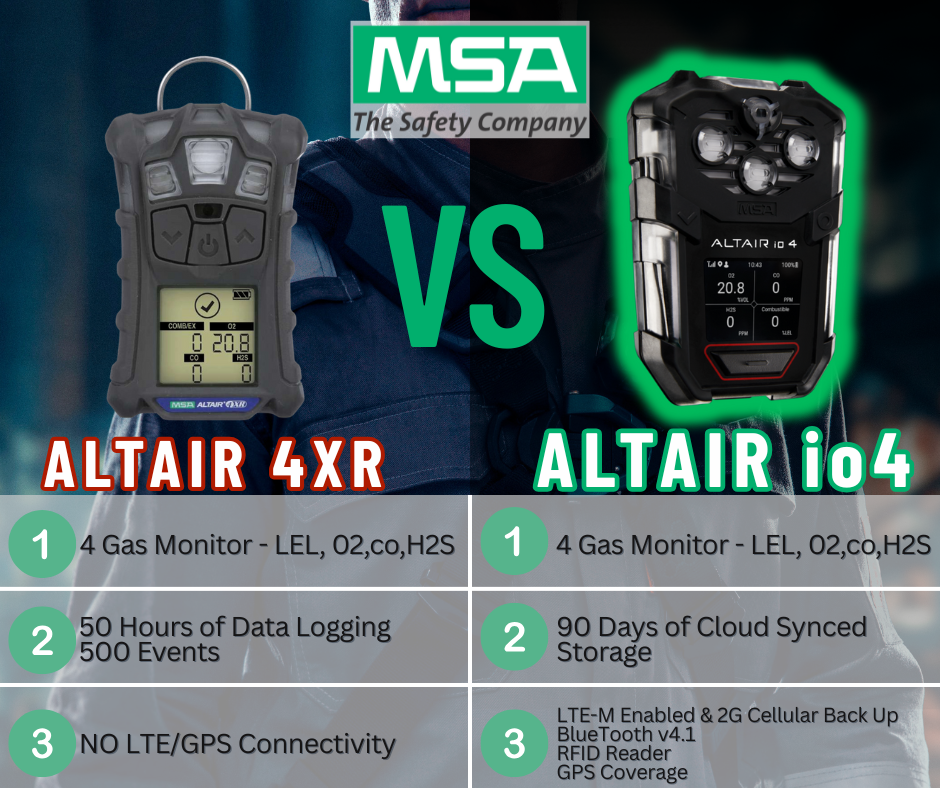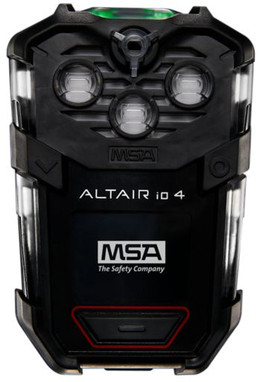MSA ALTAIR 4XR vs. MSA ALTAIR io 4: In-Depth Comparison
When it comes to personal gas detection in hazardous environments, the MSA ALTAIR 4XR and MSA ALTAIR io 4 are two of the most reliable devices on the market. Both are 4-gas detectors designed to monitor the presence of LEL (Lower Explosive Limit), O2 (Oxygen), CO (Carbon Monoxide), and H2S (Hydrogen Sulfide). Despite their similar core functionalities, these devices differ in several key areas, including battery life, weight, advanced connectivity features, and more. This comprehensive guide will help you understand the differences and determine which device best suits your needs.

| Comparison Chart | ||
| Typical Configuration | 4-Gas (LEL, O2, Co, H2S) | 4-Gas (LEL, O2, Co, H2S) |
| Battery | Rechargable | Rechargable |
| Charge Time | 4-Hour | 4.5-Hour |
| Run Time | 24-Hour | 17-Hour |
| Weight | 8 oz. | 9 oz. |
| Datalogging | >50 Hours / >500 Events | 90-day cloud-synced data logs |
| Warranty | 4 Years | 4 Years Unlimited Warranty with Subscription |
| Connectivity | ||
| Realtime Remote Connectivity | No | Yes |
| RFID Enabled | No | Yes |
| LTE (Cellular) | No | Yes |
| BlueTooth | No | Yes |
| Location Awareness (GPS) | No | Yes |
| GPS Accuracy | n/a | 8 ft. |
| MSA Grid Capable | No | Yes |
| Calibration | ||
| Allows Manual Calibration | Yes | Yes |
| Docking Station Calibration | Yes | Yes |
| Durability | ||
| Drop Test (MIL-STD-810G) | Yes | Yes |
| Water & Dust Proof | Yes | Yes |
| 60 Minute Tumble Test | No | Yes |
Typical Configuration and Core Features
Both the ALTAIR 4XR and the ALTAIR io 4 are designed with a typical 4-gas configuration. They monitor LEL, O2, CO, and H2S, making them suitable for a wide range of industries, from construction and oil & gas to manufacturing. This similarity ensures that either device will provide fundamental protection in environments where these hazardous gases are a concern.
Summary: Which Should You Choose?
- You prioritize longer battery life for extended shifts.
- You want a lighter, no-frills device.
- You need standard gas detection without advanced features.
- You work in a high-risk, tech-enabled environment.
- You require real-time tracking, LTE, GPS, and Bluetooth.
- You want seamless integration with modern safety systems.
Conclusion
Both gas detectors offer rugged, reliable solutions tailored to different job environments. The ALTAIR 4XR is a dependable choice for straightforward, long-shift applications. In contrast, the ALTAIR io 4 adds smart features and real-time connectivity that shine in complex or large-scale operations. Whichever you choose, both provide industry-trusted protection where it matters most.
Recent Posts
-
Unlock 2025 Tax Savings with Section 179
SECTION 179 • 2025 GUIDE Unlock 2025 Tax Savings with Section 179 A practical guide for small busi …Oct 15, 2025 -
MSA ALTAIR 4XR vs. MSA ALTAIR io 4: In-Depth Comparison
When it comes to personal gas detection in hazardous environments, the MSA ALTAIR 4XR and MSA ALTAIR …Nov 01, 2024 -
How to Read a Hard Hat Expiration Date
Understanding the expiration date of a hard hat is critical for ensuring workplace safety. Hard hats …Jul 26, 2024




